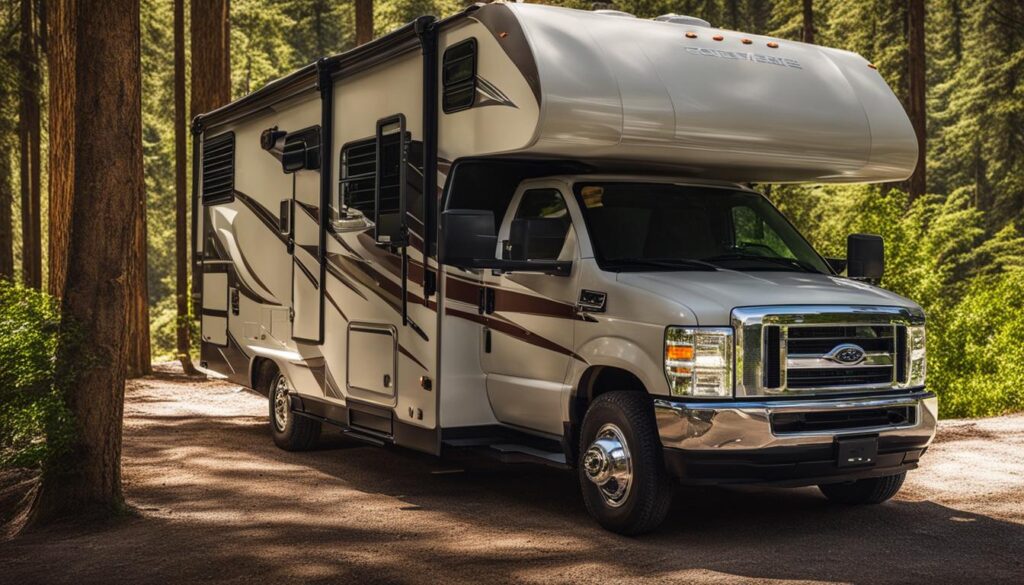Do RVs have air conditioning? If you’ve ever wondered how you can stay cool and comfortable during your RV travels, you’re in the right place. RV air conditioners are a game-changer for those hot and humid days on the road, but have you ever thought about how they actually work? Let’s dive into the functionality of RV air conditioning units and unravel the secrets behind their cooling power.
Key Takeaways:
- RV air conditioners use refrigerants to remove heat and cool down the interior of the RV.
- There are different types of RV air conditioners, including roof-mounted units and portable units.
- Proper maintenance and cleaning are crucial for the optimal functioning of RV air conditioners.
- RV air conditioners have specific power requirements measured in amps and watts.
- Understanding the different types of RV air conditioners can help you choose the right one for your needs and RV configuration.
Contents
Understanding RV Air Conditioner Power Requirements
When it comes to RV air conditioners, understanding their power requirements is crucial for optimal performance. RV air conditioners operate on specific power specifications, which are typically measured in amps and watts. By considering these power requirements, you can ensure that your RV’s electrical system can adequately support the air conditioner’s needs.
An average RV air conditioner draws between 11 and 16 amps, depending on factors such as size and efficiency. The running wattage of an RV air conditioner can range from 500 to 2,000 watts, again depending on the unit’s size and efficiency.
To put it into perspective, let’s take a look at how many amps and watts an RV air conditioner typically uses:
| RV Air Conditioner | Amps | Watts |
|---|---|---|
| Small Unit | 11-13 Amps | 1,200-1,600 Watts |
| Medium Unit | 13-15 Amps | 1,500-1,800 Watts |
| Large Unit | 15-16 Amps | 1,800-2,000 Watts |
It’s important to note that these are general estimates and may vary based on the specific make and model of your RV air conditioner.
When determining whether your RV’s electrical system can support the power requirements of the air conditioner, you’ll need to consider the power source available. RVs typically come with either 30-amp or 50-amp service, which will dictate the capacity of the electrical system. It’s essential to match the power source with the power requirements of the air conditioner to ensure compatibility.
In situations where you’ll be camping without access to electrical hookups, you may need to use a generator to power your RV air conditioner. It’s important to choose a generator that can handle the wattage and amperage requirements of your specific air conditioner model.
Understanding the power requirements of your RV air conditioner is essential for a comfortable and hassle-free RV travel experience. By ensuring that your RV’s electrical system can support the air conditioner’s needs, you can enjoy cool and refreshing indoor temperatures during your adventures.

Maintaining and Troubleshooting Your RV Air Conditioner
Proper maintenance and troubleshooting are essential for keeping your RV air conditioner in good working order. By following a few simple steps, you can ensure that your RV air conditioner continues to cool your vehicle effectively, even in the hottest climates.
Regular Maintenance Tasks
- Cleaning and inspecting the air filter: The air filter in your RV air conditioner helps to prevent dust and debris from entering the unit. Over time, the filter may become clogged, restricting airflow and reducing cooling efficiency. Clean or replace the air filter every 3-4 months to maintain optimal performance.
- Checking and cleaning the coils and fins: The coils and fins in your air conditioner can become dirty or covered in debris, hindering the unit’s ability to transfer heat effectively. Regularly inspect and clean these components to ensure proper airflow and cooling.
- Inspecting the shroud: The shroud is a protective covering that shields the AC components mounted on the roof of your RV. Check for cracks or damage, as a damaged shroud can impact the efficiency and functionality of your air conditioner.
Troubleshooting Common Issues
If you encounter problems with your RV air conditioner, there are a few troubleshooting steps you can take:
- Check thermostat settings: Ensure that the thermostat is set to the desired cooling temperature and mode of operation. Incorrect settings can prevent the air conditioner from turning on or cooling effectively.
- Ensure proper power supply: Verify that your RV is receiving adequate power and that the air conditioner is properly connected to the electrical source. A faulty power supply can prevent the unit from turning on or cooling properly.
- Check for airflow obstructions: Inspect the vents and ducts for any obstructions that may be preventing adequate airflow. Clear away any debris or blockages to restore proper air circulation.
If troubleshooting steps do not resolve the issue, it may be necessary to consult a professional for repairs or replacement of the air conditioner unit.

Regular maintenance and troubleshooting can help extend the lifespan of your RV air conditioner and ensure that it continues to provide efficient cooling for your travels.
Different Types of RV Air Conditioners
RV air conditioners come in various types to suit different RV configurations and personal preferences. Understanding the different options available can help RV owners make informed decisions when choosing the right air conditioner for their vehicles.
Roof-Mounted RV Air Conditioner
The most common type of RV air conditioner is the roof-mounted unit. As the name suggests, this air conditioner is installed on the roof of the RV and provides cool air to the interior. It is designed to fit snugly on the roof and has a sleek profile to minimize wind resistance. Roof-mounted air conditioners are typically ducted systems, allowing the cool air to be distributed evenly throughout the RV.
Portable RV Air Conditioner
For those seeking flexibility and convenience, portable air conditioners are a popular choice. These units can be moved around and placed in specific areas of the RV, providing targeted cooling where it is needed most. Portable air conditioners are self-contained and do not require installation on the roof or any modifications to the RV. They generally come with exhaust hoses that need to be vented outside the RV to expel hot air.

Ducted RV Air Conditioner
In ducted RV air conditioning systems, the cool air is distributed through a network of air vents and ducts installed throughout the RV. This allows for more even cooling and eliminates hot spots. Ducted systems are ideal for larger RVs with multiple rooms or compartments.
Non-Ducted RV Air Conditioner
Non-ducted RV air conditioners, also known as direct-vent or self-contained units, blow cool air directly into the living space, similar to window air conditioners. These units are powerful and can provide quick cooling, but they may create temperature variations within the RV. Non-ducted air conditioners are often more affordable and easier to install than ducted systems.
Low-Profile RV Air Conditioner
Low-profile RV air conditioners are designed for improved aerodynamics and reduced clearance requirements. They have a sleek and compact design, making them a popular choice for RVs with height restrictions, such as Class B or pop-up campers. Despite their low profile, these units can still provide efficient cooling for smaller RVs.
Standard-Profile RV Air Conditioner
Standard-profile RV air conditioners are larger units that offer greater cooling power. They are commonly found in larger RVs, such as Class A or Class C motorhomes. These units have a higher profile and may require more roof clearance. Standard-profile air conditioners are suitable for RVs that require robust cooling capabilities.
The choice of RV air conditioner type depends on factors such as the RV model, available space, and personal preferences. Each type has its advantages and considerations, so it’s essential to choose the one that best fits the needs of your RV and camping lifestyle.
RV Air Conditioners and Heating Systems
In addition to ensuring comfortable temperatures in hot climates, RVs need proper heating systems to keep the interior warm during colder temperatures. Two common options for RV heating are heat pumps and propane furnaces.
Heat pumps utilize electricity to warm the RV and are often integrated into the rooftop air conditioner units. These systems are suitable for mild cold weather but may struggle to provide sufficient heat in more extreme temperatures.
On the other hand, propane furnaces rely on propane gas to generate heat. These furnaces are capable of keeping the RV warm even in freezing temperatures. Propane furnaces offer reliable heating in a wide range of cold weather conditions.
To ensure the functionality of both the air conditioning and heating systems in an RV, it is essential for owners to understand their operation and perform regular maintenance. Additionally, it is important to consider the power requirements and limitations of each system to avoid any issues during RV travel.
FAQ
How does an RV air conditioner work?
RV air conditioners work by using refrigerants to remove heat and cool down the interior of the RV. They pull warm air out of the vehicle, circulate it through evaporators, compressors, condenser coils, and fans, and then recirculate it, dropping the temperature.
What are the power requirements of an RV air conditioner?
The power requirements of an RV air conditioner are typically measured in amps and watts. The average RV air conditioner draws between 11 and 16 amps and has a running wattage that can range from 500 to 2,000 watts, depending on the size and efficiency of the unit.
How should I maintain and troubleshoot my RV air conditioner?
Regular maintenance tasks for RV air conditioners include cleaning and inspecting the air filter, checking and cleaning the coils and fins, and ensuring proper airflow. Troubleshooting common issues may involve checking thermostat settings, power supply, and airflow obstructions.
What are the different types of RV air conditioners?
The different types of RV air conditioners include roof-mounted, portable, ducted, and non-ducted units. Roof-mounted air conditioners are installed on the roof and provide overall cooling, while portable units can be moved around. Ducted units ensure consistent airflow, and non-ducted units blow air directly, similar to window units.
What heating systems are available for RVs?
RV heating systems can include heat pumps and propane furnaces. Heat pumps use electricity and are integrated into the rooftop air conditioner, while propane furnaces use propane gas. It’s important to understand how to use and maintain both systems, considering their power requirements and limitations.






